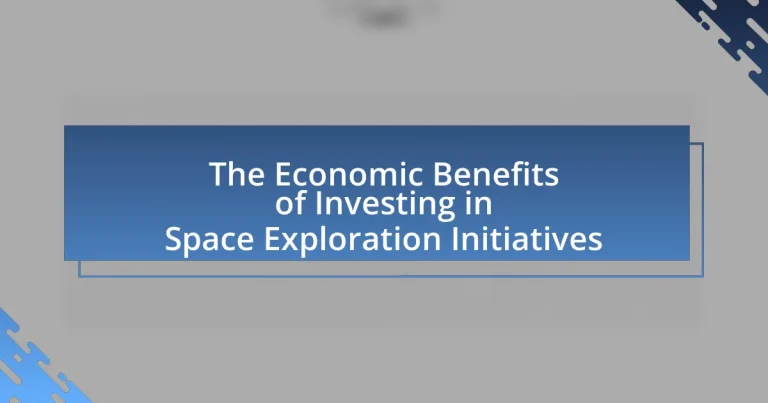The main entity of the article is the economic benefits derived from investing in space exploration initiatives. The article outlines how such investments lead to significant job creation, technological advancements, and increased global competitiveness, with the U.S. space industry alone supporting over 1 million jobs and contributing approximately $200 billion annually to the economy. It discusses the direct economic impacts of space exploration, including the stimulation of various sectors such as aerospace, telecommunications, and materials science, while highlighting the importance of both public and private investments. Additionally, the article emphasizes the broader societal benefits, international collaboration, and potential markets that could emerge from these investments, ultimately illustrating the substantial long-term economic implications of space exploration.

What are the Economic Benefits of Investing in Space Exploration Initiatives?
Investing in space exploration initiatives generates significant economic benefits, including job creation, technological advancements, and increased global competitiveness. For instance, the space industry in the United States alone supports over 1 million jobs and contributes approximately $200 billion to the economy annually. Furthermore, technologies developed for space missions, such as satellite communications and GPS, have led to innovations that enhance various sectors, including telecommunications and transportation. Additionally, countries that invest in space exploration often experience a boost in their STEM workforce, fostering a culture of innovation that can lead to new industries and economic growth.
How does space exploration contribute to economic growth?
Space exploration contributes to economic growth by driving technological innovation, creating jobs, and fostering new markets. The development of technologies for space missions often leads to advancements in various sectors, such as telecommunications, materials science, and robotics, which can enhance productivity and efficiency in the economy. For instance, NASA’s investment in satellite technology has significantly improved global communication and navigation systems, generating billions in economic value. Additionally, the space industry creates high-skilled jobs; the Space Foundation reported that the U.S. space economy employed over 1 million workers in 2020. Furthermore, space exploration stimulates private sector investment, as seen with companies like SpaceX and Blue Origin, which have attracted substantial funding and contributed to economic activity through commercial space ventures.
What specific sectors benefit from investments in space exploration?
Investments in space exploration primarily benefit the aerospace sector, telecommunications, Earth observation, and materials science. The aerospace sector gains from advancements in technology and manufacturing processes, as evidenced by the growth of companies like SpaceX and Boeing, which have seen increased revenue due to government and private contracts. Telecommunications benefits through the deployment of satellites that enhance global communication networks; for instance, the global satellite industry was valued at approximately $271 billion in 2020, driven by investments in space. Earth observation services, which provide critical data for agriculture, disaster management, and climate monitoring, have expanded significantly, with the market projected to reach $7.5 billion by 2025. Lastly, materials science sees advancements through research in developing new materials for extreme environments, leading to innovations that can be applied in various industries on Earth.
How does space exploration drive technological innovation?
Space exploration drives technological innovation by necessitating advancements in engineering, materials science, and computer technology to solve complex challenges. For instance, the development of lightweight materials for spacecraft has led to innovations in industries such as automotive and construction, where similar materials are now used to enhance fuel efficiency and structural integrity. Additionally, the need for precise navigation and communication in space missions has spurred advancements in satellite technology, which have been applied to global positioning systems and telecommunications. Historical examples include NASA’s development of the integrated circuit in the 1960s, which laid the groundwork for modern computing. These innovations not only support space missions but also create economic opportunities and improve everyday technologies on Earth.
Why is public and private investment in space exploration important?
Public and private investment in space exploration is important because it drives technological innovation and economic growth. Investments from government agencies like NASA and private companies such as SpaceX have led to advancements in satellite technology, telecommunications, and materials science. For instance, NASA’s investment in the development of the Space Launch System has spurred the growth of the commercial space sector, creating thousands of jobs and generating billions in economic activity. Additionally, the global space economy was valued at approximately $447 billion in 2020, highlighting the significant financial returns associated with these investments.
What role do government agencies play in funding space initiatives?
Government agencies play a crucial role in funding space initiatives by allocating significant financial resources and establishing policies that support space exploration. For instance, NASA, the United States’ primary space agency, has a budget of approximately $24 billion for fiscal year 2023, which is directed towards various projects including the Artemis program aimed at returning humans to the Moon. Additionally, government funding often stimulates private sector investment; for example, contracts awarded to companies like SpaceX and Blue Origin have led to advancements in commercial spaceflight. This public funding not only facilitates technological innovation but also generates economic growth, as evidenced by the space industry contributing over $400 billion to the global economy in 2020.
How do private companies contribute to the economic landscape of space exploration?
Private companies significantly enhance the economic landscape of space exploration by driving innovation, reducing costs, and increasing access to space. For instance, companies like SpaceX have lowered launch costs through reusable rocket technology, which has made space more accessible for various stakeholders, including governments and research institutions. In 2020, SpaceX’s Falcon 9 launch cost was approximately $2,720 per kilogram to low Earth orbit, compared to traditional launch providers that charged upwards of $10,000 per kilogram. Additionally, private companies stimulate job creation and economic growth; the space industry in the U.S. employed over 360,000 people in 2019, with private sector jobs growing rapidly as investments in space initiatives increase. Furthermore, private companies attract significant investment; for example, venture capital funding in the space sector reached $5.7 billion in 2020, indicating strong investor confidence and potential for economic returns.

What are the direct economic impacts of space exploration initiatives?
The direct economic impacts of space exploration initiatives include job creation, technological advancements, and increased investment in related industries. Space exploration initiatives generate employment opportunities; for instance, NASA’s budget for 2021 was approximately $23.3 billion, supporting over 300,000 jobs across various sectors. Additionally, these initiatives drive technological innovations that often find applications in commercial markets, such as satellite technology and materials science. The space sector also attracts significant private investment; in 2020, global investment in space startups reached $5.7 billion, indicating a growing economic ecosystem linked to space exploration.
How does space exploration create jobs and stimulate employment?
Space exploration creates jobs and stimulates employment by driving demand for skilled labor in various sectors, including engineering, technology, and manufacturing. The National Aeronautics and Space Administration (NASA) reported that for every $1 billion spent on space exploration, approximately 8,000 jobs are created in the U.S. economy. This includes direct employment in aerospace companies, research institutions, and support industries, as well as indirect jobs in sectors such as construction and services that support the space industry. Additionally, investments in space initiatives lead to innovation and the development of new technologies, which further expand job opportunities across multiple fields, contributing to overall economic growth.
What types of jobs are generated by the space industry?
The space industry generates a variety of jobs, including engineering, manufacturing, research and development, operations, and support roles. Engineers design spacecraft and satellites, while manufacturing jobs focus on producing components and systems. Research and development positions involve creating new technologies and methodologies for space exploration. Operations roles manage missions and ensure the functionality of space systems, and support jobs provide administrative, logistical, and technical assistance. According to the Space Foundation’s “Space Report 2021,” the global space economy was valued at $447 billion, highlighting the industry’s significant contribution to job creation and economic growth.
How do these jobs impact local economies?
Jobs created by space exploration initiatives significantly boost local economies by increasing employment opportunities and stimulating local businesses. For instance, the aerospace sector often leads to the establishment of new companies and the expansion of existing ones, which in turn creates jobs in engineering, manufacturing, and support services. According to a report by the Space Foundation, the global space economy was valued at $423 billion in 2019, with a substantial portion of that growth benefiting local communities through job creation and increased economic activity. Additionally, these jobs often come with higher-than-average salaries, which enhances local purchasing power and drives demand for goods and services in the area.
What is the return on investment for space exploration initiatives?
The return on investment for space exploration initiatives is estimated to be around $10 for every $1 spent. This figure is supported by various studies, including a report from the Space Foundation, which highlights that investments in space lead to advancements in technology, job creation, and economic growth. For instance, NASA’s budget of approximately $22 billion in 2020 generated over $64 billion in economic output, demonstrating a significant multiplier effect. Additionally, the development of technologies such as GPS and satellite communications, which originated from space exploration, has created entire industries, further validating the high return on investment.
How can we measure the economic returns from space missions?
Economic returns from space missions can be measured through various metrics, including direct financial returns, job creation, technological advancements, and societal benefits. Direct financial returns can be quantified by analyzing the revenue generated from commercial activities, such as satellite communications and Earth observation services, which collectively contribute billions to the global economy. For instance, the satellite industry alone generated approximately $271 billion in revenue in 2020, according to the Satellite Industry Association.
Job creation is another critical metric; space missions often lead to the development of high-skilled jobs in engineering, manufacturing, and research sectors. The National Aeronautics and Space Administration (NASA) reported that every dollar spent on its programs generates about $10 in economic returns, highlighting the multiplier effect of investment in space initiatives.
Technological advancements resulting from space missions also provide economic returns by fostering innovation that spills over into other industries. For example, technologies developed for space exploration have led to advancements in materials science, telecommunications, and medical devices, which can drive economic growth.
Lastly, societal benefits, such as improved disaster response capabilities and enhanced environmental monitoring, can be quantified through cost savings and improved quality of life, further illustrating the economic impact of space missions. Overall, a comprehensive assessment of these factors provides a robust framework for measuring the economic returns from space missions.
What are some successful case studies of profitable space investments?
Successful case studies of profitable space investments include SpaceX, Planet Labs, and Iridium Communications. SpaceX has achieved profitability through its reusable rocket technology, significantly reducing launch costs and securing contracts with NASA and commercial clients, resulting in over $3 billion in revenue by 2021. Planet Labs, which operates a fleet of Earth-imaging satellites, has generated substantial revenue by providing data analytics services to various industries, reporting $100 million in annual revenue in 2021. Iridium Communications, known for its satellite communication services, has successfully transitioned to a new satellite constellation, leading to increased revenue and a market capitalization of approximately $1.5 billion as of 2023. These examples demonstrate the financial viability and growth potential of investments in the space sector.

What are the broader societal benefits of investing in space exploration?
Investing in space exploration yields significant broader societal benefits, including technological advancements, economic growth, and international collaboration. Technological advancements from space exploration often lead to innovations that improve everyday life, such as satellite technology that enhances communication and weather forecasting. The space sector contributes to economic growth by creating jobs; for instance, NASA’s budget supports over 300,000 jobs in the U.S. alone, according to a 2020 report by the Space Foundation. Furthermore, international collaboration in space initiatives fosters peaceful relations and shared knowledge among countries, exemplified by partnerships in the International Space Station program, which includes multiple nations working together for scientific progress. These benefits illustrate the multifaceted positive impact of investing in space exploration on society as a whole.
How does space exploration enhance global collaboration and partnerships?
Space exploration enhances global collaboration and partnerships by fostering international cooperation on scientific research and technological development. Collaborative projects, such as the International Space Station (ISS), involve multiple countries working together, sharing resources, expertise, and funding, which strengthens diplomatic ties and promotes peaceful relations. For instance, the ISS is a joint effort involving space agencies from the United States, Russia, Europe, Japan, and Canada, demonstrating how shared goals in space can unite nations. Additionally, joint missions and research initiatives, like the Mars exploration programs, encourage countries to pool their knowledge and capabilities, leading to advancements that benefit humanity as a whole.
What international agreements support economic benefits from space initiatives?
The Outer Space Treaty of 1967 is a key international agreement that supports economic benefits from space initiatives by establishing a framework for the peaceful use of outer space. This treaty encourages international cooperation in space exploration, which can lead to shared technological advancements and economic opportunities. Additionally, the Convention on Registration of Objects Launched into Outer Space, adopted in 1976, promotes transparency and accountability in space activities, fostering an environment conducive to investment and economic growth in the space sector. These agreements collectively facilitate collaboration among nations, enhancing the potential for economic benefits derived from space initiatives.
How do collaborative projects lead to shared economic gains?
Collaborative projects lead to shared economic gains by pooling resources, expertise, and risk among multiple stakeholders, which enhances innovation and reduces costs. For instance, in space exploration, partnerships between government agencies and private companies, such as NASA and SpaceX, have resulted in significant advancements in technology and reduced launch costs. According to a report by the Space Foundation, collaborative efforts in the space sector have generated over $400 billion in economic activity, demonstrating that shared investments can yield substantial financial returns for all parties involved.
What are the long-term economic implications of space exploration?
The long-term economic implications of space exploration include significant advancements in technology, job creation, and the potential for resource utilization. Space exploration drives innovation, leading to new technologies that can be applied in various industries; for instance, NASA’s development of satellite technology has revolutionized telecommunications and weather forecasting. Additionally, the space sector is projected to create millions of jobs; the Space Foundation reported that the global space economy was valued at $469 billion in 2020 and is expected to grow substantially. Furthermore, the potential for mining asteroids and utilizing resources from other celestial bodies could provide new materials and energy sources, significantly impacting global economies. These factors collectively indicate that investment in space exploration can yield substantial long-term economic benefits.
How might advancements in space technology influence future economies?
Advancements in space technology are likely to significantly influence future economies by driving innovation, creating new markets, and enhancing global collaboration. For instance, the commercial space sector, valued at approximately $424 billion in 2020, is projected to grow to over $1 trillion by 2040, indicating substantial economic potential. Furthermore, technologies developed for space exploration, such as satellite communications and Earth observation, have already transformed industries like agriculture, telecommunications, and disaster management, leading to increased efficiency and productivity. Additionally, investments in space initiatives foster international partnerships, which can lead to shared technological advancements and economic benefits across nations.
What potential markets could emerge from space exploration investments?
Potential markets that could emerge from space exploration investments include satellite services, space tourism, asteroid mining, and in-orbit manufacturing. The satellite services market is projected to grow significantly, with the global satellite industry valued at approximately $271 billion in 2020 and expected to reach $500 billion by 2025, driven by advancements in communication and Earth observation technologies. Space tourism is also gaining traction, with companies like SpaceX and Blue Origin investing heavily; the space tourism market could reach $3 billion by 2030. Additionally, asteroid mining presents opportunities for extracting valuable resources, with estimates suggesting that the materials in asteroids could be worth trillions of dollars. In-orbit manufacturing, which allows for the production of goods in microgravity, is anticipated to revolutionize industries such as pharmaceuticals and materials science, potentially creating a market worth billions. These emerging markets highlight the diverse economic benefits of investing in space exploration initiatives.
What practical steps can stakeholders take to maximize economic benefits from space exploration?
Stakeholders can maximize economic benefits from space exploration by fostering public-private partnerships that leverage investment and innovation. These collaborations can lead to cost-sharing in research and development, as evidenced by NASA’s Commercial Crew Program, which has successfully engaged private companies like SpaceX and Boeing, resulting in reduced costs and increased capabilities for human spaceflight. Additionally, stakeholders should prioritize the development of space-related technologies that have terrestrial applications, such as satellite communications and Earth observation, which can generate revenue streams and create jobs. For instance, the global satellite industry was valued at approximately $271 billion in 2020, highlighting the economic potential of space-derived technologies. Furthermore, stakeholders can advocate for policies that support sustainable practices in space exploration, ensuring long-term viability and economic returns. By implementing these strategies, stakeholders can effectively harness the economic potential of space exploration initiatives.


